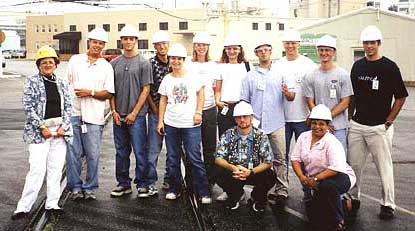Luz Martinez-Miranda
Luz Martinez-Miranda learned physics in a unique way. Her teacher at University High School in Rio Piedras, Puerto Rico began not with vector addition and multiplication, but with optics. “There was something about lenses and things that attracted me in particular and made me want to study more,” Martinez-Miranda said – she thought the optics problems dealt with real physics, which she found fascinating. She went on to study physics at the University of Puerto Rico, where her teachers were very supportive of her physics aspirations. “When I came [to MIT] for graduate school,” she said, “I knew I could do physics.”
 Luz Martinez-Miranda and colleagues.
Luz Martinez-Miranda and colleagues.
Today, Martinez-Miranda is a professor at the University of Maryland. She studies liquid crystals, substances that flow like liquids but have order to their molecules in one direction, as crystals do. Liquid crystals are used in electronic displays; for example, the dark material that forms numbers on calculators is a liquid crystal. Liquid crystals also form part of the cell membranes in biological cells. Martinez-Miranda studies how the container that holds the liquid crystal interacts with the liquid itself. She has also applied for money to study biological molecules like collagen, a protein that can grow into either bone or skin tissue. Martinez-Miranda's biological research could someday help scientists better understand how the body builds bone, and how doctors can mimic that process. “People who know more about this than I do can use it to aid in bone reconstruction,” she said.
Martinez-Miranda was born in Maryland, but moved to Puerto Rico with her family at age five. At age seven, she and her brother started music lessons. While still in high school, Martinez-Miranda entered the Music Conservatory of Puerto Rico to study piano. “I balanced it with my physics,” she said. When she completed her physics degree, she nearly had enough credits to add a second degree in piano. “I had only a few courses left, and it seemed terrible not to finish,” she said. She stayed long enough to graduate with joint degrees in physics and music performance. After adding a Master's degree in physics from Puerto Rico, she went on to graduate school at MIT.
Unlike the University of Puerto Rico, where many students commute from home to classes, most MIT students live on campus. Physics classes at MIT were also much larger than those at the University of Puerto Rico. “MIT was the first time I was living in a university environment,” Martinez-Miranda said. “It wasn't a shock, but it was different.”
She also felt singled out as a woman in physics, something she had never felt in Puerto Rico. “When I came here, there was more of a resistance toward women,” she said. “If I argued something, they wouldn't take it seriously. When a guy said the same exact thing, they would believe it.” Martinez-Miranda said that she felt similarly singled out in her later physics career, but less so as she has gained more experience.
In graduate school and in her professional life, Martinez-Miranda has learned to complete quality work without spending all her time in her lab. “You have to strike a balance,” she said. She still plays the piano, but she doesn't own one. Instead, she owns a harpsichord, an instrument similar to the piano that was popular in the 1700s, on which she plays music by composers such as Johann Sebastian Bach.
Martinez-Miranda tries to encourage students to study physics, as her teachers had encouraged her in high school and college. She recommends that students get as much math and hands-on experience as they can, and tells students not to give up. “After you get through the basics, you move on to the really interesting things,” she said.











